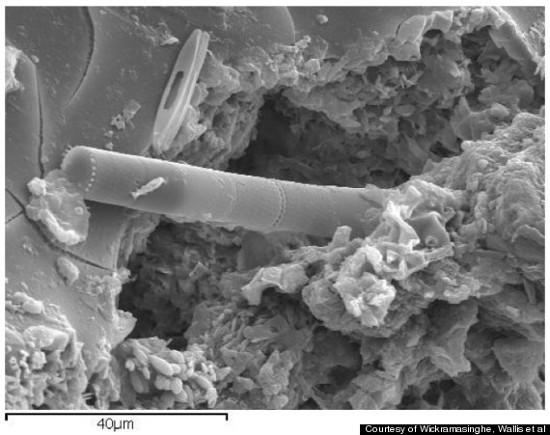Scientists claim they've got fossilized proof of alien lifeforms
(We only know lot of Alien thuggers from UN/USA/EU - mine)
"Wickramasinghe is a fervent proponent of [panspermia]. Like, really fervent. So much so that he attributes everything to life in space," Plait wrote. "He's claimed living cells found in the stratosphere come from space. (There is no evidence at all they do, and it's far more likely they are terrestrial). ... Wickramasinghe jumps on everything, with little or no evidence, and says it's from outer space, so I think there's a case to be made for a bias on his part."

The above image was taken from an electron microscope's view of a meteorite found last month in Sri Lanka. According to Chandra Wickramasinghe, the director of Buckingham Centre for Astrobiology at the University of Buckingham in the U.K., that wormlike shape in the image is a diatom ("a type of microscopic plant life"), and if his research is correct, it came from outer space.
In studying the meteorite Wickramasinghe and his colleagues found "a microstructure and morphology characteristic of a wide class of terrestrial diatoms," and "the presence of structures of this kind in any extraterrestrial setting could be construed as unequivocal proof of biology." In other words, these fossils match similar lifeforms found on Earth, but because they were found on a meteorite, the researchers believes they didn't come from Earth. So Wickramasinghe and company believe they've found definite proof of at least microscopic forms of life in outer space.
Wickramasinghe and his late colleague Sir Fred Hoyle together developed a theory known as "panspermia," the idea that life is all over the universe and that asteroids and comets help to carry it around. Wickramasinghe has been working for much of his life to prove the theory, and he believes that with this research he has.
"We conclude ... that the identification of fossilised diatoms [as shown in the image below] in the Polonnaruwa meteorite is firmly established and unimpeachable. Since this meteorite is considered to be an extinct cometary fragment, the idea of microbial life carried within comets and the theory of cometary panspermia is thus vindicated," he wrote in a research paper on the diatoms.
But not everyone is convinced. Astronomer Phil Plait, who you may have seen around herebefore, believes Wickramasinghe is just seeing what he wants to see in the meteorite.
"Wickramasinghe is a fervent proponent of [panspermia]. Like, really fervent. So much so that he attributes everything to life in space," Plait wrote. "He's claimed living cells found in the stratosphere come from space. (There is no evidence at all they do, and it's far more likely they are terrestrial). ... Wickramasinghe jumps on everything, with little or no evidence, and says it's from outer space, so I think there's a case to be made for a bias on his part."
Critics also point out that the rock could be from Earth, and allege Wickramasinghe isn't giving this possibility enough credence. But as far as he's concerned, Wickramasinghe and his team have discovered ironclad evidence of alien life.
"Over a few years, after a great deal of model-fitting, we came to the conclusion that material similar to biomaterial fitted all the available data in astronomy ... We considered the possibility that biology (microbiology) had a universal character, and no observations in astronomy or new information from biology has provided contrary evidence," he said.
So what do you think? Is Wickramasinghe right, or do you want a second opinion?
(Via Huffington Post)

No comments:
Post a Comment